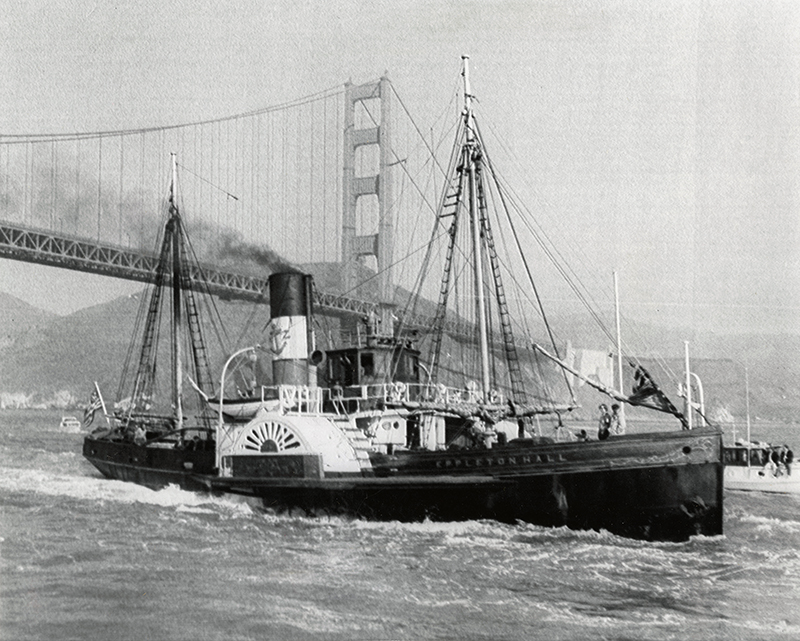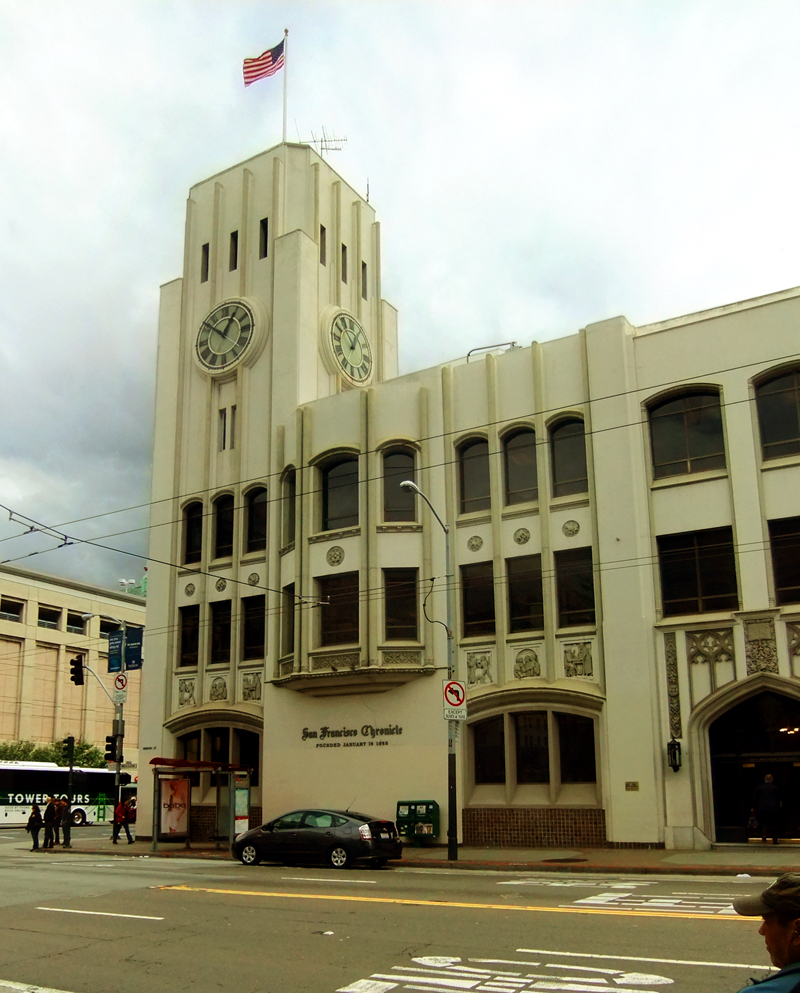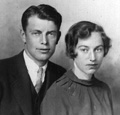|
|


Click image to enlarge
Captain Scott Newhall's Eppleton Hall — England's last functioning side-lever paddle-wheel tugboat — enters the Golden Gate in late March 1970, completing a harrowing 11,000-mile journey from a shipbreaking yard at Newcastle-on-Tyne where Newhall saved her from a very different fate. Scott Newhall, then-editor of the San Francisco Chronicle and owner of The Newhall Signal newspaper, and wife Ruth Waldo Newhall are standing at the bow of the boat in this 7x8½-inch newswire telephoto from the archive of the (Spokane, Wash.) Spokesman-Review, where it was published April 1, 1970. Its caption reads:
Steam tug Eppleton Hall, which left England six months ago, is shown churning its way under the Golden Gate Bridge. The 105-foot sidewheel paddle, described as the last of her kind,
was skippered by Scott Newhall, executive editor of the San Francisco Chronicle.
A substantially similar photograph, shot just seconds earlier, was published in Scott Newhall's 1971 book about the adventure (pg. 301). His caption reads:
After a short stay in San Diego, where hospitality flowed like vintage brandy, the Eppleton Hall dutifully turned once again toward the north [after navigating the Panama Canal],
headed for the Golden Gate. After a voyage that was surprisingly free of hazard except for a tense three hours in absolutely blind fog off the Golden Gate, the Eppleton Hall turned
right and splashed under the Golden Gate, to her new home. During the entire voyage, she had never paddled so fast nor flaunted her Edwardian charm with so much flair as she did during the
victorious entrance into San Francisco's world-celebrated harbor.
Both Scott Newhall and the Eppleton Hall had entered the world in 1914. Fifty-five years later, Newhall was in his prime but the tired old tugboat "had been on the mud for almost two years and was burned out, water-filled and rusty" (pg. 20) when Newhall became enthralled with her story, purchased her and hired shipbuilders to salvage her on behalf of the San Francisco Maritime Museum. Donated to the National Park Service in 1979, she's berthed at Hyde Street Pier in San Francisco.
Information on the Eppleton Hall from TUGS WIKI: The Eppleton Hall is a paddle wheel tugboat built in England in 1914. The only remaining intact example of a river tyne paddle tug, and one of only 2 surviving British-built paddle tugs (the other John H. Amos), she's preserved at the San Francisco Maritime Historical National Park in California. O.J. is likely based on the Eppleton Hall. Eppleton Hall was built in 1914 by Hepple & Co. of South Shields, for the Lambton & Hetton Collieries, Ltd, and named after the Lambton family ancestral home near Penshaw. A steam powered side wheeler with side-lever engines, she was designed to tow ocean-going coal-carrying ships to & from Tyne Dock, which served Newcastle upon Tyne. For sailing ships, this saved time, while for larger motor vessels it saved navigation & pilotage costs. She was also used to tow newly-built ships to the North Sea. She operated from 1914-46 by Hepple & Co., who post WWII were nationalised as part of the National Coal Board. Being rather old now, rather that being transferred to the British Transport Commission like many of the former collieries transportation assets,she was sold to France Fenwick, Wear & Tyne Ltd., which after refurbishment operated her on the River Wear until 1964. In 1952, the tug was modified slightly to obtain a passenger certificate, so that she could obtain, so that she could transport officials from newly-launched steamers, after the boats had completed their sea trials. In 1964 she was one of the last 3 steam tugs decommissioned in the River Tyne, sold from Sunderland Harbour Dock C. in November 1964. Sold for scrap in 1967 to Clayton & Davie, while sitting on a mud bank in Duston as part of the scrap process fire destroyed her afterdeck and interior. This tugboat is no longer in service in San Francisco Harbour, but she is still there as a landmark. The news of the fate of the last Tyne-Paddle-Tug reached Karl Kortum, then director of the San Francisco Maritime Museum. Kortum instructed associate Scott Newhall to proceed to the Scrap Yard & Purchase the vessel, and then restore her for return to San Francisco. Restored at Bill Quay, Sunderland, from 1969-79 Eppleton Hall served as the Private Yacht of Kortum, modified for the trans-Atlantic Ocean journey to San Francisco via the Panama canal she passed through the Golden Gate Bridge in March, 1970. Newhall subsequently wrote the book "The Eppleton Hall", which tells the story of the discovery, restoration & journey from the Tyne to San Francisco of the ship. (Howell North Books, Berkeley, CA, 1971). Donated by Kortum to the USA National Park Service in 1979, she's now berthed at Hyde Street Pier, San Francisco. She's presently being restored her condition post-War 1946, when refurbished for France Fenwick, Wear & Tyne Ltd. Link to Newhall's book on the Eppleton Hall When Scott Newhall became executive editor of the San Francisco Chronicle in 1952, its circulation was half that of William Randolph Hearst's Examiner. Scott was determined to eclipse the Examiner in subscriptions — and when he did, it was champagne on ice for the entire staff. A teetotaler himself, Scott stuck to ginger ale.
Scott was born Jan. 21, 1914, in San Francisco and joined the staff of the Chronicle in 1934 as a summer replacement photographer. A year earlier, during his sophomore year at UC Berkeley, he eloped with the woman who would become his lifelong companion, Ruth Waldo. The couple enjoyed sailing and antique hunting. It was during a hunt in Mexico for a lost Aztec gold mine that Scott got mad at his horse and kicked it. It kicked back and Scott ended up losing his right leg. Scott and Ruth never did find the mine, but they did go on to have four children: Skip in 1938, followed by twins Tony and Jon in 1941, then daughter Penelope (Penny) in 1943. Penny died in a runaway truck accident in 1955. By the early 1960s, still the hired head of someone else's Chronicle, Scott set out to buy a newspaper of his own. In 1963 the Santa Clarita Valley's weekly newspaper, The Newhall Signal and Saugus Enterprise — named both for his great-grandfather Henry and for Henry's Massachusetts birthplace — came on the market. Scott and Ruth purchased it, commuting to Newhall to run it. It was "game on" as Scott introduced Santa Clarita Valley readers to his inimitable editorial style along with his motto, "Vigilance Forever," which made its first appearance Jan. 9, 1964. Scott was familiar with the area as a shareholder in the family business, The Newhall Land and Farming Co., which at one time owned 46,460 acres of the Santa Clarita Valley and now was preparing to build an entire "new town" called Valencia. Tired of living out of suitcases, Scott and Ruth rented, then purchased the Warring mansion in Piru in 1968. All the while, Scott was still running the show at the Chronicle. He had one more thing to do before he left the Bay Area for good: In 1971 he ran for mayor of San Francisco. It didn't work out too well. Scott captured just 3.44 percent of the vote, finishing fifth behind incumbent Joseph Alioto and third-place challenger Dianne Feinstein. After that, Piru and the Santa Clarita Valley became the Newhalls' permanent home. Scott ramped up his editorial fervor, calling for the head of a bureaucrat or politician one day and threatening to drop king-sized diapers by helicopter the next, because those darned cows shouldn't be roaming the hills naked in view of freeway motorists. The Santa Clarita Valley of the 1960s and '70s was known casually as the "Newhall-Saugus area" or the "Newhall-Saugus-Valencia-Canyon Country area." Believing the valley needed a solid, memorable name, Scott instructed reporters to refer to the area as "Valencia Valley" in news stories, but it didn't catch on with readers — especially those in Canyon Country who weren't necessarily enamored with Newhall Land or its new town. Scott and Ruth traded off the top staff positions at the paper over the years and engaged sons Jon and Tony to share in the editorial and publishing responsibilities. Despite competition from the Los Angeles Times and Daily News, aka the Valley News & Green Sheet, the Newhalls turned a small, local weekly paper into a twice-weekly in 1965, then thrice-weekly in 1966 as they marched toward eventual daily publication. The Newhalls' community participation wasn't limited to newsprint. In 1972, Newhall family members organized the first Santa Clarita Valley Boys & Girls Club Auction. It was Ruth who came up with the idea of forming the Santa Clarita Valley Historical Society in 1975; a decade later, it was Ruth who convinced other community leaders that the time was right to form a city. By that time, Scott and Ruth had set the wheels in motion to relinquish control of The Signal. Back in 1972 they brought in an investor in the person of Charles Morris, a young newspaper publisher in the South, and used his money to pay off the bank loan they had used in 1963 to buy the paper. The new money gave Morris an option to buy The Signal after six years. When 1978 came, Scott and Ruth wanted to buy him out, but Morris chose instead to exercise his option. In terms of circulation, The Signal was Morris' largest property in California. Morris would end up owning the paper longer than anyone — 37 years. Scott and Ruth asked to stay on as editors in 1978 and signed a 10-year noncompetition agreement. In 1986 they shepherded The Signal through its move from 6th Street in Newhall to "Auto Row" in Valencia to be in close proximity to their major advertisers, who had made the same move a decade earlier. In 1988 when the 10-year mark arrived, Scott and Ruth left the building — and opened their own shop right down the street on Valencia Boulevard, intent on beating The Signal in circulation as Scott had done decades earlier to Hearst. This time the outcome would be different. Eight months and $1.3 million later, their thrice-weekly Citizen newspaper folded and Scott rode off into the sunset. In 1992, acute pancreatitis landed Scott at Henry Mayo Newhall Memorial Hospital in Valencia, where he died Oct. 26 of that year. He was 78. For a quarter-century, from 1963 to 1988 at The Signal and beyond with The Citizen, Scott and Ruth Newhall recorded, influenced and molded the goings-on in the Santa Clarita Valley as the area grew from a sleepy L.A. backwater into a vibrant, self-sustaining family community.
LW3081: 9600 dpi jpeg from original wire photo purchased 2017 by Leon Worden.
|
SEE ALSO:
Oral History 1988/89
Family Photos x7
World Cruise 1936
Scott, Skip, Tony, Jon 1944
Chronicle x3
Buys Signal 1963
12/23/1965
Anguilla 1967
Scott in England 1969
Eppleton Hall 1970
Pinback: Scott for Mayor 1971
Scott for Mayor 1971
Tony Newhall & Clarion Publisher Jackie Storinsky 1971
Signal Ingot ~1973
Signal 1980s
Silver Spur 1991
Signal Special Edition Upon Scott's Death 1992
Historical Society 2/1993
Video: Ruth Interview 2000
• Ruth Obituary 1
Ruth Tribute 1/2004
|
The site owner makes no assertions as to ownership of any original copyrights to digitized images. However, these images are intended for Personal or Research use only. Any other kind of use, including but not limited to commercial or scholarly publication in any medium or format, public exhibition, or use online or in a web site, may be subject to additional restrictions including but not limited to the copyrights held by parties other than the site owner. USERS ARE SOLELY RESPONSIBLE for determining the existence of such rights and for obtaining any permissions and/or paying associated fees necessary for the proposed use.




















